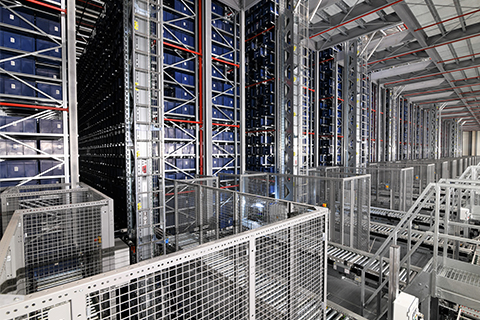AGVs in production supply
Read more

Even if a warehouse is still running smoothly today, further automation can make sense. After all, various problem areas in the warehouse can still provide an indication that automation would be a remedy: Be it for lack of space, because the warehouse capacity is limited and there is no room for even more workers. But in addition to optimization opportunities like this, warehouse automation also results in fewer errors, shortened lead times and reduced costs. "Fair enough," you might say now, "but how do you keep track of everything?" The answer: with a warehouse control system ( WCS), for example. Now, there are "warehouse control systems" (WCS) and pure "warehouse management systems" (WMS). Often these or similar designations are mixed with each other, which then usually causes confusion. We clarify how the most important terms differ and what they have in common.
A warehouse control system (WCS ) is used in logistics when additional comprehensive functions are required to control a warehouse beyond pure "accounting" storage location management. This is often the case with warehouse automation or partial automation. This is because partially and fully automated warehouses require a higher-level control system, a WCS. Its task is to control and monitor all processes in the warehouse. Furthermore, other systems that are important for intralogistics (e.g. material flow computers, ERP, shipping systems, customs systems, etc.) are also connected via the WCS.
In general, three levels of automation are distinguished based on their degree of mechanization:
Tip: We have already described more about the individual automation levels in this blog post: "When does automation in the warehouse make sense? Gradations in warehouse automation".
Suitable software is required for efficient operation. For this purpose, the Warehouse Control System is integrated and linked to the other, higher-level systems. For example, for the "full automation" expansion stage, all existing systems are integrated in order to synchronize and coordinate the processes. With the help of the WCS, the various control software of the individual automated, mechanized components can then synchronize (e.g. PLC controls for stacker cranes, conveyor elements, lifting and turntables, sorters, loops, shuttles, lifts, etc.).
Figuratively speaking, the WCS is comparable to the spinal cord in a person's body, which is necessary to carry out movements such as running or walking.
To stay with the comparison with the human body, the Warehouse Management System (WMS), on the other hand, is the "brain". This is because, as the "intelligence" of the warehouse, a WMS indicates what needs to be done and transmits these instructions as commands to the "body". Goods movements in the warehouse remain in a state of flux as a result of the WMS's instructions.
It can be noted that the term "Warehouse Management System" is comparatively more familiar than the previously mentioned WCS/warehouse control systems. In addition, there are "enterprise WMS" systems, which are both: both WMS and WCS. One of the most widely used warehouse management systems in the world, SAP EWM from the leading software manufacturer SAP in Walldorf, is particularly well known.
A WMS is capable of handling the complete management of one or more logistics centers. Therefore, these systems are mainly found in larger companies or in large warehouses and logistics centers.
The management options include
The WCS controls and monitors all intralogistics processes and material flows:
When a company decides to push ahead with warehouse automation, the use of a powerful software solution is inevitable. Those who speak of a WCS usually mean a holistic control tool for logistics processes in the warehouse.
In practice, however, the names of the various solutions are of secondary importance. Instead, one will first determine how large the actually required scope of services is and what the requirements are. This is because it is possible to find out whether a combination of WMS and WCS is suitable, for example. For SAP customers, on the other hand, this question hardly arises, since the SAP EWM "supplied" by SAP as an enterprise WMS already includes both functional components anyway.
WCS, WMS, LVS, MFR, MFS - abbreviations and terminology or not: Don't be confused by the various common names! A WCS (Warehouse Control System) and WMS (Warehouse Management System) are two different components with different strengths, which partly overlap in their functionality. In the end, however, it comes down to finding the right solution for your logistics center that best meets its needs - regardless of which acronym you choose.
Do you have any questions, such as which system we recommend, specifically about WCS or warehouse automation in general? Contact us for a joint exchange or join us live at one of our webinars. There you will gain insights into already realized projects and learn how we have solved demanding challenges in the logistics and production environment based on SAP standard software together with our customers.
You can also find out more about warehouse automation and logistics planning here.